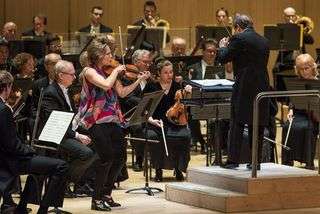|
Back
A hesitant start to the new year Toronto
Roy Thomson Hall
01/10/2019 - & January 12, 13, 2019
Kurt Weill: Kleine Dreigroschenmusik
Igor Stravinsky: Concerto in D Major for Violin
Jean Sibelius: Symphony No. 2 in D Major, Op. 43
Leila Josefowicz (violin)
The Toronto Symphony Orchestra, Ludovic Morlot (conductor)

L. Josefowicz & L. Morlot (© Nick Wons)
The TSO started off 2019 with this program of three concerts under Ludovic Morlot, replacing David Robertson. Overall it went well, if in a rather cautious way.
The opening work, The Little Threepenny Music, required just 17 players: no strings, but with accordion, banjo, and two saxophones. We think of twenties jazz as bouncy and joyous, but this work displays a world-weariness (or world wariness) even in its laconic overture. The muted trumpet during the familiar “Mack the Knife” tune seems to ask “Are we having fun yet?” Even the jauntier pieces seem to dance at the edge of an abyss, and the ending is mock-triumphalist. The performance successfully captures its tone of unease.
Weill’s 20-minute work was first performed in 1929, a year after the stage work he and Bertolt Brecht created (and which turned out to be such an epoch-defining hit). The following year the Paris-based Igor Stravinsky, well into what we now perceive as his neo-classical phase, composed his Violin Concerto. It shares similarities with the Weill work, what with a deadpan jauntiness in the opening movement, offset by the violinist’s warmth, at least when the instrument is in the hands of Leila Josefowicz. The third movement, “Aria II”, contains more lyricism, but throughout one listens in vain for any big statement. The opening chord that returns in each subsequent movement stands in as the work’s sonic “trademark”.
The second half of the program gave us a favourite work, the Sibelius Symphony No. 2, a piece that we have heard in recent years under Thomas Dausgaard and John Storgårds. With its opulent sound world (lots of strings) unlike the astringent works in the first half. For me it conjures up events occurring in geologic time. The orchestra was in fine form and, although the tension lapsed in places, the grand build toward the finale was as spacious as one could wish.
Michael Johnson
|